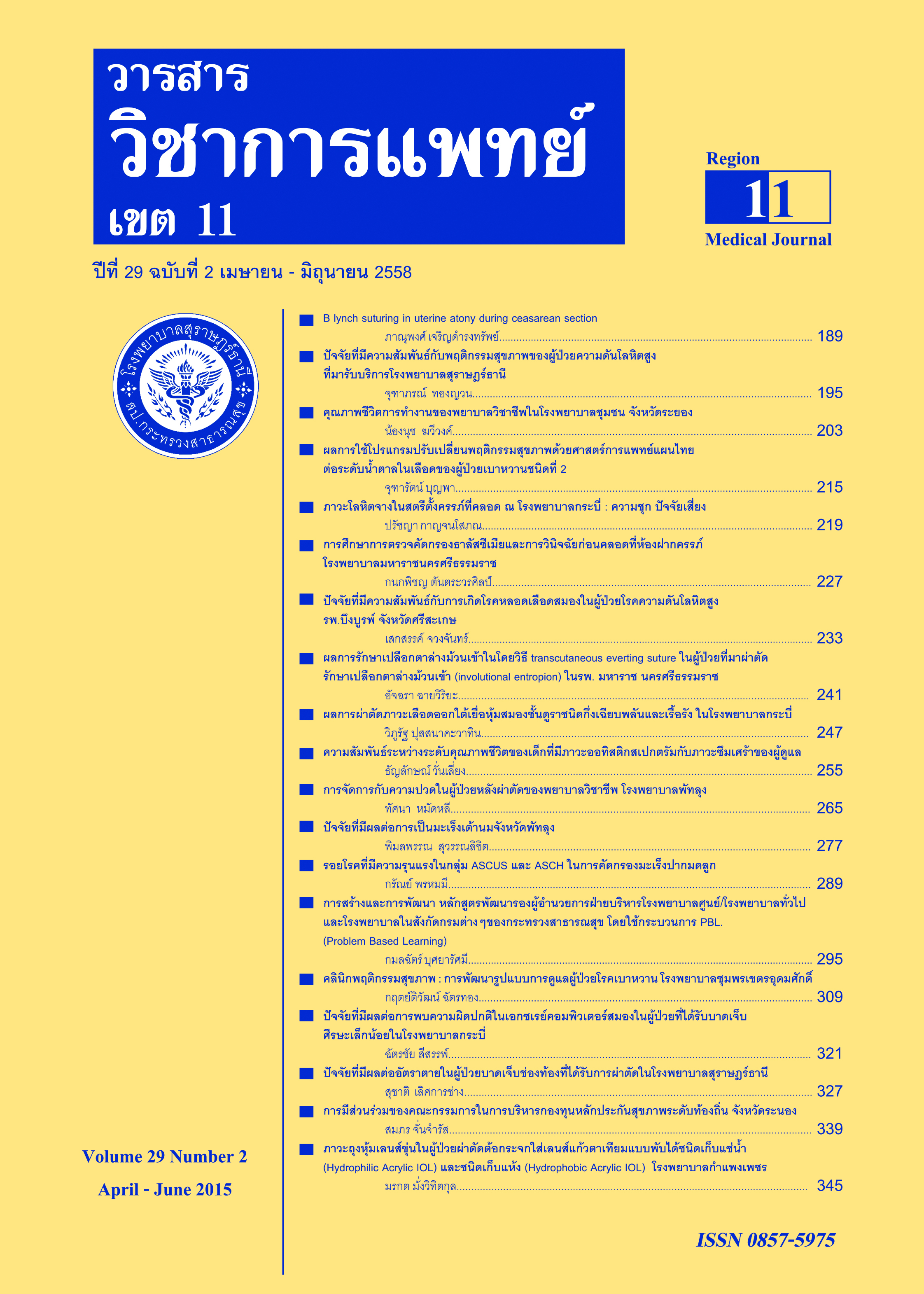Factors related to Health behavioral among Hypertensive Patients at Surattani Hospital
Keywords:
Health behavioral among hypertensive patientsAbstract
This research study was aimed to investigated the factors related to Health behavioral among Hypertensive patients at Surattani Hospital, Suratthani Province. The sample study was composed 242 at Surattani Hospital. Data were collected from questionnaire which develop from Jinda Muengken (1998) consisted 1) personal data contained sex, age, status, education, occupation, source of income, income, house, care giver, period of disease and complication 2) knowledge due to hypertension test and 3) health behavioral among hypertensive patients. The questionnaires were tested for content validity and reliability by Kuder-Richardson were 0.76 and Cronbach’s coefficient were 0.81. The data were analyzed by using percentage, mean, standard deviation, Chi-square test and Pearson Product Moment Correlation coefficient. The results of study showed that education, income and complication were related to health behavioral among hypertensive patients with the significantly at the .05. The sex, status, care giver and knowledge were related to health behavioral among hypertensive patients with the significantly at the 01.
References
2. สำนักนโยบายและยุทธศาสตร์ สำนักงานปลัดกระทรวงสาธารณสุข. (2556). ข้อมูลสถิติ. สืบค้นเมื่อ 22 สิงหาคม 2555,ออนไลน์: http://bps.ops.moph.go.th/.
3. Black Henry, Richard, and William J, Elliott. (2007). Hypertension: A Companion to Brannwald’s Heart Disease. Canada: Sauder, and imprint of Elsvier
Inc,
4. ธวัชชัย ภาสุรกุล.(2552). รู้จักเลี่ยงไม่เสี่ยงเป็นความดันโลหิตสูง. สืบค้นเมื่อวันที่ 1 กรกฎาคม 2556,จาก URL: http:// www.vcharkarn.com/vblog/62788.
5. World Health Organization. (1983). “Primary Prevention of Essential Hypertension”. World Health Organization Technical Report,
6. Hickey, J. V. (2003). The Clinical Practice of Neurological and Neurosurgical Nursing (5th ed.). Philadelphia: Lippincott Williams & Wilkins.
7. Joint National Committee. (2003). The seventh report of the joint national committee on prevention,detection, evaluation and treatment of high blood pressure (JNC VII). Hypertension, 42(6), 2106-2152.
8. สรัญญา พิจารณ์.(2547). การสนับสนุนจากพยาบาลและพฤติกรรมสุขภาพของผู้ที่มีความดันโลหิตสูงโรงพยาบาลดอยสะเก็ดจังหวัดเชียงใหม่. วิทยานิพนธ์พยาบาลศาสตรมหาบัณฑิต สาขาการพยาบาลผู้สูงอายุ, บัณฑิตวิทยาลัย, มหาวิทยาลัยเชียงใหม่.
9. Clark, L.T. (1991). Improving compliance and increasing control of hypertension: needs of special hypertensive populations. American Heart Journal,121(2), 664-6698.
10. ภัสราวลัย ศีติสาร อรุณวรรณ สุวรรณรัตน์ และ จารุวรรณ ใจลังกา. ปัจจัยที่มีผลต่อพฤติกรรมการดูแลตนเองของผู้ป่วยภาวะความดันโลหิตสูงที่ควบคุมไม่ได้โรงพยาบาลดอกคำใต้ อำเภอดอกค?ำใต้ จังหวัดพะเยา. วารสารสาธารณสุขล้านนา,9(2) (พ.ค. – ส.ค.); 2556.
11. จินดา ม่วงแก่น. (2551). ปัจจัยผู้ป่วยและปัจจัยครอบครัวที่มีอิทธิพลต่อพฤติกรรมสุขภาพของผู้ป่วยโรคความดันโลหิตสูง.วิทยานิพนธ์ปริญญาพยาบาลศาสตรมหาบัณฑิต สาขาวิชาการพยาบาลเวชปฏิบัติครอบครัว, คณะพยาบาลศาสตร์, มหาวิทยาลัยนเรศวร.
12. วรรณวิสา รอดกล่อม และคณะ. (2555). การสนับสนุนทางสังคมและความเชื่อด้านสุขภาพกับพฤติกรรมการดูแลตนเองของผู้ป่วยโรคความดันโลหิตสูงชนิดไม่ทราบสาเหตุที่มารับบริการของโรงพยาบาลพรหมพิรามจังหวัดพิษณุโลก.วารสารการพยาบาลและสุขภาพ, 6(2) (พ.ย. –ส.ค.); 2557.
13. นงเยาว์ ใบยา. (2554). ปัจจัยผู้ป่วยและปัจจัยครอบครัวที่มีอิทธิพลต่อพฤติกรรมสุขภาพของผู้ป่วยโรคความดันโลหิตสูง.วิทยานิพนธ์พยาบาลศาสตรมหาบัณฑิต สาขาวิชาการพยาบาลเวชปฏิบัติครอบครัว, คณะพยาบาลศาสตร์,มหาวิทยาลัยบูรพา.
14. วิริยา สุขวงศ์, ธนพร วรรณกูล, และชลิดา โสภิตภักดีพงษ์. (2554). ประสิทธิผลของโปรแกรมสุขศึกษาโดยประยุกต์ใช้ทฤษฎีการดูแลตนเองในผู้ป่วยความดันโลหิตสูง. รายงานวิจัย มหาวิทยาลัยราชภัฎสวนสุนันทา.
15.สุรีรัตน์ กุลเฉลิม. (2554). ปัจจัยผู้ป่วยและปัจจัยครอบครัวที่มีอิทธิพลต่อพฤติกรรมสุขภาพของผ้ปู ่วยโรคความดันโลหิตสูง. วิทยานิพนธ์วทยาศาสตรมหาบัณฑิต สาขาวิชาเอกการพยาบาลสาธารณสุข,บัณฑิตมหาวิทยาลัย, มหาวิทยาลัยมหิดล.
16.Wright, L. M., & Leahey, M. (2009). Nursing and Families: A Guide to Family Assessment and Intervention. Philadelphia: F.A. Davis.
17.Bandura, A. (1997). Self-efficacy: The Exercise of Control. New York: W.H. Freeman.
18. สุกัญญา คุขุนทด. (2552). ผลของโปรแกรมสุขศึกษาแก่ผู้ป่วยโรคความดันโลหิตสูงในโรงพยาบาลด่านขุนทด จังหวัดนครราชสีมา. วิทยานิพนธ์หลักสูตรครุศาสตรมหาบัณฑิต สาขาการส่งเสริมสุขภาพ, มหาวิทยาลัยราชภัฎนครราชสีมา.
19. สุธีรา ฮุ่นตระกูล และ วิไลพรรณ สมบุญตนนท์. (2555). การพัฒนาศักยภาพของผู้ป่วยโรคความดันโลหิตสูงในการดูแลตนเองเพื่อป้องกันภาวะแทรกซ้อน.วารสารพยาบาลทหารบก,13(3) (ก.ย. - ธ.ค.); 2555.
20. ภัสราวลัย ศีติสาร อรุณวรรณ สุวรรณรัตน์ และจารุวรรณ ใจลังกา.ปัจจัยที่มีผลต่อพฤติกรรมการดูแลตนเองของผู้ป่วยภาวะความดันโลหิตสูงที่ควบคุมไม่ได้โรงพยาบาลดอกคำใต้อำเภอดอกคำใต้ จังหวัดพะเยา. วารสารสาธารณสุขล้านนา,9(2) (พ.ค. – ส.ค.); 2556.
21. เนาวรัตน์ จันทานนท์ บุษราคัม สิงห์ชัย และวิวัฒน์วรวงษ์. (2011). พฤติกรรมการดูแลตนเองของผู้ป่วยโรคความดันโลหิตสูงในอำเภอเมืองจังหวัดชุมพร.สืบค้นเมื่อวันที่ 28 มกราคม 2558,ออนไลน์ http://www.resjournal.kku.ac.th/abstract/16_6_749.pdf
22. National Heart, Lung, & Blood Institute.(2006c). Treatment of high blood pressure. Retrieved Dec.16, 2006, fromhttp://www.nhlbi.nih.gov/hbp/treat/treat.htm.






